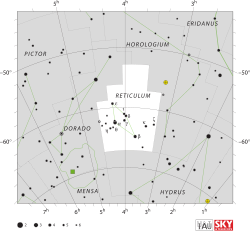레티쿨리 델타
Delta Reticuli| 관측 데이터 Epoch J2000.0 이쿼녹스 J2000.0(ICRS) | |
|---|---|
| 별자리 | 레티쿨룸속 |
| 우측 상승 | 03h 58m 44.74945s[1] |
| 탈위임 | −61° 24′ 00.6673″[1] |
| 겉보기 크기 (V) | 4.60[2] |
| 특성. | |
| 진화 단계 | 점근성 거목[3] |
| 스펙트럼형 | M2 III[4] |
| U-B색지수 | +2.02[2] |
| B-V색지수 | +1.61[2] |
| 변수형 | 의심됨[5] |
| 아스트로메트리 | |
| 방사 속도 (Rv) | -1.4±2.8km[6]/s |
| 고유 운동 (μ) | RA: +9.80[1]mas/yr Dec.: −14.30[1]mas/yr |
| 시차 (π) | 6.20 ± 0.25[1] 마스 |
| 거리 | 530 ± 20 리 (105 ± 7 pc) |
| 절대치수 (MV) | −1.47[7] |
| 세부 사항 | |
| 반지름 | 56[8] R☉ |
| 루미도 | 1,100[9] L☉ |
| 온도 | 3,891[9] K |
| 기타 지정 | |
| 데이터베이스 참조 | |
| 심바드 | 자료 |
델타 레티쿨리(Delta Ret, Δ Leticuli, Δ Ret)는 레티쿨룸 남쪽 별자리에 있는 별이다.그것은 육안으로 볼 수 있으며, 겉보기에는 4.60의 시야를 가지고 있다.[2]이 별과의 거리는 연간 시차 변화 6.20 mas로 추정되며,[1] 태양으로부터 약 530광년 떨어져 있다.
이것은 M2 III라는 별의 분류를 가진 점근거성 가지에 있는 진화된 적색거성별이다.[3][4]태양 반경의 약 56배까지[8] 확장되었으며, 3,891K의 유효온도로 서늘한 외부 대기에서 태양 광도의 1,100배를 방사한다.[9]
델타 레티쿨리는 태양에 비해 13.3km/s의 속도로 은하수를 통과해 이동하고 있다.그것의 예상 은하 궤도는 은하 중심에서 22,700에서 30,400광년 사이에 그것을 운반한다.[11]
참조
- ^ a b c d e f van Leeuwen, F. (2007), "Validation of the new Hipparcos reduction", Astronomy and Astrophysics, 474 (2): 653–664, arXiv:0708.1752, Bibcode:2007A&A...474..653V, doi:10.1051/0004-6361:20078357, S2CID 18759600.
- ^ a b c d Feinstein, A. (1966), "Photoelectric observations of Southern late-type stars", The Information Bulletin for the Southern Hemisphere, 8: 30, Bibcode:1966IBSH....8...30F.
- ^ a b Eggen, O. J. (1992), "Asymptotic giant branch stars near the sun", The Astronomical Journal, 104: 275, Bibcode:1992AJ....104..275E, doi:10.1086/116239.
- ^ a b Houk, Nancy; Cowley, A. P. (1979), Michigan catalogue of two-dimensional spectral types for the HD stars, vol. 1, Ann Arbor, Michigan: Dept. of Astronomy, University of Michigan, Bibcode:1978mcts.book.....H.
- ^ Samus, N. N.; Durlevich, O. V.; et al. (2004), "Combined General Catalogue of Variable Stars (GCVS4.2)", VizieR On-line Data Catalog, Institute of Astronomy of Russian Academy of Sciences and Sternberg State Astronomical Institute of the Moscow State University, Bibcode:2004yCat.2250....0S.
- ^ de Bruijne, J. H. J.; Eilers, A.-C. (October 2012), "Radial velocities for the HIPPARCOS-Gaia Hundred-Thousand-Proper-Motion project", Astronomy & Astrophysics, 546: 14, arXiv:1208.3048, Bibcode:2012A&A...546A..61D, doi:10.1051/0004-6361/201219219, S2CID 59451347, A61.
- ^ Anderson, E.; Francis, Ch. (2012), "XHIP: An extended hipparcos compilation", Astronomy Letters, 38 (5): 331, arXiv:1108.4971, Bibcode:2012AstL...38..331A, doi:10.1134/S1063773712050015, S2CID 119257644.
- ^ a b Pasinetti Fracassini, L. E.; et al. (2001), "Catalogue of Apparent Diameters and Absolute Radii of Stars (CADARS)", Astronomy & Astrophysics (3rd ed.), 367: 521–24, arXiv:astro-ph/0012289, Bibcode:2001A&A...367..521P, doi:10.1051/0004-6361:20000451, S2CID 425754.
- ^ a b c McDonald, I.; et al. (2012), "Fundamental Parameters and Infrared Excesses of Hipparcos Stars", Monthly Notices of the Royal Astronomical Society, 427 (1): 343–57, arXiv:1208.2037, Bibcode:2012MNRAS.427..343M, doi:10.1111/j.1365-2966.2012.21873.x, S2CID 118665352.
- ^ "del Ret". SIMBAD. Centre de données astronomiques de Strasbourg. Retrieved 2017-02-14.
{{cite web}}: CS1 maint : 포스트스크립트(링크) - ^ "Delta Reticuli (HIP 18597)". Archived from the original on 2014-04-14. Retrieved 2012-08-17.



